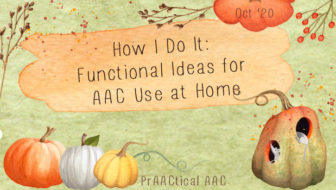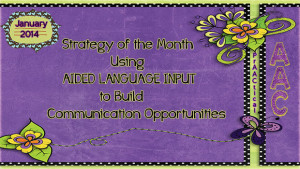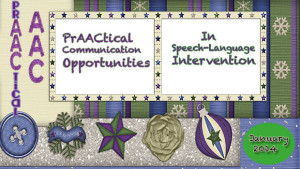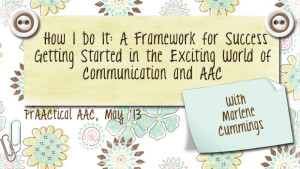Tag Archive: communication opportunities
October 22, 2020
by Carole Zangari -

Speech-language pathologists who serve individuals with complex communication generally have less time than they’d like to support families in implementing AAC at home. In today’s post, guest author Jesse Kleinman shares her ideas for using functional activities to support AAC learning. As an SLP in Brooklyn New York, she provides in-person and remote therapy to students with AAC needs. Enjoy! ::::::::::::::::::::::::::::::::::::::::::::::::::::::::::::::::::::::::::::::::::::::::::::::::::: How I Do It: Functional Ideas for AAC Use at Home During this time, we have all been spending a lot of time at home to stay safe. It has been a trying time in these past couple of months, but as therapists, we are always adapting. As a speech-language pathologist, I was thrown into the world of teletherapy for about 6 months, and I’m now doing a hybrid approach where I see some of my students in person and others remotely. I’ve been seeing a majority of my... [Read More...]
Filed under: Featured Posts, PrAACtical Thinking
Tagged With: communication opportunities, downloads, Families caregivers and home
March 28, 2019
by Carole Zangari -

Eva doesn’t seem to be interested in any of the books or playthings her SLP typically uses, and reinforcer preference testing was inconclusive. Zach tends to grab the teacher’s materials and put them in his mouth, or sometimes bang them on a hard surface. Bryce often engages with them for a few seconds then drops or throws them. Do you work with students like these? They have lots of AAC learning ahead of them, but creating therapy sessions or instructional lessons is a challenge because of the ways in which they interact with the materials. For some students, keeping the number of materials to a minimum can be helpful. Here are a few things to try. Create activities where the focus is on movement rather than on materials. Create a simple movement game or make up your own version of a childhood classic (e.g., Red Light, Green Light) that... [Read More...]
Filed under: Featured Posts, PrAACtical Thinking
Tagged With: communication opportunities, implementation ideas, play
August 4, 2014
by Carole Zangari -

Build it and they will come.
Filed under: PrAACtical Thinking
Tagged With: communication opportunities
January 27, 2014
by Robin Parker -

We can not write, speak or do enough Aided Language Input (ALI). If we expect learners to speak AAC, we must speak AAC to them. It is difficult enough to learn a language and imagine if no one spoke it to you in the language you were expected to speak…But there are so many more reasons to do ALI. Aided Language Input (ALI) belongs in the context of communication opportunities. It is modeling AAC style. Once we model a target language concept AAC style, then add the wait and signal strategy, the learner then knows it is their communicative turn. Especially if you wait with the raised eye brow signal. They often will take their turn expressively. But, if they do not take the communicative opportunity to take their turn, there are gestural, visual, verbal, and physical prompts that can be implemented. In other words, they can make use of... [Read More...]
Filed under: Strategy of the Month
Tagged With: aided language input, ALI, communication opportunities
January 13, 2014
by Robin Parker -

Planning for communication opportunities in every aspect of speech-language therapy helps ensure productive use of time and effort for both clinician and learner. It is not enough to talk to a student, it is not enough to provide fun activities without lots of opportunity for active participation and more specifically communication initiation. Another word for communication initiation/opportunities is communication temptations. Communication temptations are structured situations designed to entice a variety of specific communication functions or semantic relations (Wetherby, 1988). There needs to be lots of times where there is targeted modeling and then a specific, obvious reason for the learner to be the initiator of communication. A temptation to communicate. Take a look at this sample therapy session for frequent and multiple communication opportunities. Please let us know a favorite or creative communication opportunity that you use. PrAACtical Considerations Meaningful AAC Goals– All quality speech-language intervention sessions start with meaningful... [Read More...]
Filed under: Strategy of the Month
Tagged With: communication opportunities
May 30, 2013
by Carole Zangari -

We couldn’t be more excited to have a return visit from Marlene Cummings, a wonderful SLP who is currently serving as an AAC Consultant to the AAC Team at Oakland Schools. In her first post, Marlene talked about strategies for cultivating the right mindset for AAC teaching. In this post, Marlene continues sharing elements of her Framework for Success in discussing the Knowledge Toolbox, developed with the Oakland Schools AAC Team. 5 Things in Your “Knowledge Toolbox” What is already in my “knowledge toolbox” of communication, language and learning? Yes, you do have a full toolbox. You just don’t realize it. And of course there are always new and exciting things to add. You already know this stuff!! REMEMBER??? It is important to step back and think broadly about communication and what it really does. Sometimes we get caught in the details of our work and can’t see the forest through the... [Read More...]
Filed under: PrAACtical Thinking
Tagged With: AAC team, classroom, communication opportunities, communicative competence, communicative function, communicative intent, education, How I Do It, language development, Marlene Cummings, schools
January 23, 2013
by Carole Zangari -

Want to give your AAC learners more frequent opportunities to interact with others? We love using Language Experience Surveys for this purpose. The concept is a simple one. Once you have a language goal in mind, craft a survey with a key question that the communicator can use as a conversation starter. After some instruction and practice, they can then ask people the question. You’ll need to create visual supports for the survey so that the communicator can use it as a cue and show to the interaction partners. In some surveys, the partners then use the visual support to record their responses. Putting the visual support on a clipboard works well in some situations. The simplest way to do this is with a forced-choice question with a list of response options. The survey could be about favorite TV shows or places to visit, for example, and show different options.... [Read More...]
Filed under: PrAACtical Thinking
Tagged With: communication opportunities, language experience survey, question, survey






